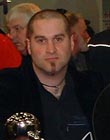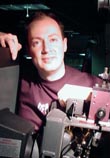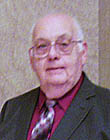|
|
This topic comprises 2 pages: 1 2
|
|
Author
|
Topic: Always carry a camera!
|
|
|
|
|
|
|
|
|
|
|
Pete Naples
Phenomenal Film Handler

Posts: 1565
From: Dunfermline, Scotland
Registered: Feb 2001
|
 posted 05-12-2005 03:14 AM
posted 05-12-2005 03:14 AM




Sorry I should have put more detail in, was a bit tired last night.
Being built in 1936 there is nothing electronic about this beast, it's all pipe with the percussions section etc being air driven. There is also a piano attached which will can be 'played' from the organ keybaord, again all air operated. Behind the scenes are two enormous blowers which supply the air, and bank of mahogany cabinets, which hold all the interlocking relays, not disimalar to an old telephone exchange.
I normally carry my wee digicam everyhwhere, it lives in the car, but this trip was by air, so I packed light, and omitted to put it in. Never again!
| IP: Logged
|
|
William Hooper
Phenomenal Film Handler
Posts: 1879
From: Mobile, AL USA
Registered: Jun 99
|
 posted 05-12-2005 07:02 AM
posted 05-12-2005 07:02 AM





Wow, it's even got the original EP relay!
Yes, that's a classic Compton cinema organ!
Control works like this:
Originally organs (like old church organs) had direct mechanical linkage between each key & a pipe. These are called "tracker" organs. Some organ people are snobs & you can tell because they sneer at theatre organs/cinema organs & act like they see themselves wearing powdered wigs. If you encounter someone like this at a church or somewhere, always ask stupid questions referring to the organ as a "tractor organ" while keeping a naive face. "This is a ... TRACTOR organ, isn't it?" When corrected on pronunciation, apologize, thank them, & continue in future references to call it a tractor organ & apologize when corrected again.
The next innovation was using a flexible tube with air to communicate between key & the valve under a pipe. A valve was located at the key, it poofed into at tube which ran into the pipe chest, & activated one or more pneumatics there to sound the organ. This type was/is called "tubular pneumatic" action.
Robert Hope-Jones came up with the "electro-pneumatic" action, in the time of THE DAWN OF ELECTRICITY. Contacts closed at the key, wires ran through any method of relays desired, as complicated as desired, ending with an electromagnet being energized under the desired pipe which pulled down a metal disc attached to a leather "pouch" admitting air from the chest (basically a constantly pressurized plenum) into the pipe.
It's all low voltage (around 12v DC), & solenoid technology hadn't advanced far enough for a great deal of mechanical advantage, so for things that needed muscle like banging percussions (drums, xylophones, opening the "swell shades" which control volume, etc.) the same setup as for pipes was used, except the magnet admitted big gulps of raw pressurized air into a pneumatic to bang whatever needed it.
The EP relays work like that, too. You'll see that they're just ganged contacts, one side is moveable, & instead of being closed by the whole thing being pulled in by an electromagnet, one valve is used to activate the raw-air-powered pneumatic which closes it.
The method is cool, the designs utilizing iterations & permutations in each organ are often amazing.
If/when you go back, if an organ guy is there, see if it's got a Compton Cube for the lowest notes in some rank, &/or if it's got a famous Compton Melotone (electronic) rank, too.
Beware the pipes themselves. They look like galvanized steel, but they're soft & often somewhat fragile: made of tin & lead alloy, basically solder!
What's the name of the theatre? Give them some ink & props for putting in not just a cinema/theatre organ, but a Compton!
| IP: Logged
|
|
|
|
|
|
|
|
William Hooper
Phenomenal Film Handler
Posts: 1879
From: Mobile, AL USA
Registered: Jun 99
|
 posted 05-13-2005 01:52 AM
posted 05-13-2005 01:52 AM





Thanks for the link, too! That's a very nice installation. Sharp, fresh, new millwork on the framing members.
Very original, not just for keeping the EP relay, but also the vintage horn speakers for the Melotone unit:
Melotone unit:
http://www.movieland.co.uk/gallery/electrone.jpg
Speaker:
http://www.movieland.co.uk/gallery/high-press.jpg
Another speaker:
http://www.movieland.co.uk/gallery/cello.jpg
And another speaker hiding behind an offset octave of metal 8's:
http://www.movieland.co.uk/gallery/diapason.jpg
They *look* like 8's, fat, but they're not reeds & not strings, & I wonder if they're metal tibias like the ones Gordon mentioned.
I can't make out the stops on the console, but it looks like there's something at 16', but I can't see any pipes for it. Since it looks like the installation is an exhibition of Compton specialties, I wonder if they *do* have a Compton Cube for 16's somewhere. They're not very spectacular in appearance, & probably wouldn't be displayed in a PR photo.
That looks like the piano off to the right in the first, wide picture with the console & pipes. Pianos were basically standard player pianos (which operate on vacuum), which were controlled via substituting a bar of magnets instead of a paper roll & tracker bar.
The chimes are unenclosed, which means they can be have double use as a Cine-Gong stand in. Are the other percussions (xylo, drums, etc. outside the pipe chamber(s), too?
The classic cinema organ lighted "jelly mold" console surround with changing colors is excellent & a delight to see functional. The only iconic feature missing is a lift. Too bad they couldn't have installed it so that it rises slowly from hiding behind the
popcorn & nacho machines to the top position up there. Probably too much hazard of getting butter & cheese in the pedal contacts.
What a fun installation, great public spot, great instrument that makes fun music, & a lobby that's got eyeball-sucking visual fun for customers! Congrats to those guys!
| IP: Logged
|
|
|
|
Stephen Furley
Film God

Posts: 3059
From: Coulsdon, Croydon, England
Registered: May 2002
|
 posted 05-13-2005 04:39 PM
posted 05-13-2005 04:39 PM




The illuminated 'jelly mould' surround to the console was very common here, but I don't think I've ever seen one on an American installation. Most were of this style, with several different colours of lighting, but the organ at the Odeon Leicester Square, also a Compton, has a quite different design. There's a picture of it
here
How exactly did the Mellotone work? I've never actually seen one, but I have heard the one at the now-closed State at Grays, Essex. I remember some years ago reading that one particular type of valve (vacuum tube) used in it was no longer available, and that various other parts were problematic, so it sounds like it is a difficult thing to keep working in original condition.
How common were ombined pipe and electronic instruments? Did any company other than Compton produce anything similar?
| IP: Logged
|
|
|
|
William Hooper
Phenomenal Film Handler
Posts: 1879
From: Mobile, AL USA
Registered: Jun 99
|
 posted 05-16-2005 03:15 AM
posted 05-16-2005 03:15 AM





quote: Stephen Furley
The illuminated 'jelly mould' surround to the console was very common here, but I don't think I've ever seen one on an American installation.
I don't know of any US illuminated surrounds, either. The use & installation of cinema organs persisted longer in the UK than the US, & illuminated surrounds were not just expected, but competitive for new achievements in theatricality in each new design. Theatre organ installations in the US pretty much hit a dead stop by 1929 (except for large, prestige houses in large urban areas), & TO's went with the orchestras. That's probably another reason why the illuminated surrounds fit in with the later UK cinema organ installs: US theatre organ consoles had to share the pit with the orchestra, & illuminated surrounds take up a lot of space!
The illuminated surrounds were used on any type of cinema organ in the UK, including Wurlitzer. Here are some more consoles with illuminated surrounds:
Long link
http://www.gbmuk.fsnet.co.uk/consoles.html
http://www.users.zetnet.co.uk/ltot/stop2.htm
They were usually custom built, considered as part of the individual organ's design. I think I read somewhere that that there was one major shop that built the illuminated surrounds in England, & that organ builders took the designs to them & had them fabricated.
quote: Stephen Furley
How exactly did the Mellotone work?
There were apparently a couple of designs, & there's information here
The Compton Melotone was the 1st combined pipe/electronic I know of (of course, there were additions of many strange acoustic noisemakers like percussions & stringed instruments, etc.), & it was pretty much the case that even a Hammond would be installed in some UK theatres before some sort of hybrid. As Ken Wuepper noted, Rodgers (bought later by Roland, which may still own it) was the company that got the electronic/pipe hybrids to work best. Rodgers devised turnkey rebuilds of church organs with electronic & pipe additions, but the most common electronic addition (for church & TO's) was an electronic 32' stop. Walker organs has pretty much become the benchmark for digital TO's & additions now.
| IP: Logged
|
|
|
|
All times are Central (GMT -6:00)
|
This topic comprises 2 pages: 1 2
|
Powered by Infopop Corporation
UBB.classicTM
6.3.1.2
The Film-Tech Forums are designed for various members related to the cinema industry to express their opinions, viewpoints and testimonials on various products, services and events based upon speculation, personal knowledge and factual information through use, therefore all views represented here allow no liability upon the publishers of this web site and the owners of said views assume no liability for any ill will resulting from these postings. The posts made here are for educational as well as entertainment purposes and as such anyone viewing this portion of the website must accept these views as statements of the author of that opinion
and agrees to release the authors from any and all liability.
|

 Home
Home
 Products
Products
 Store
Store
 Forum
Forum
 Warehouse
Warehouse
 Contact Us
Contact Us




 Printer-friendly view of this topic
Printer-friendly view of this topic















